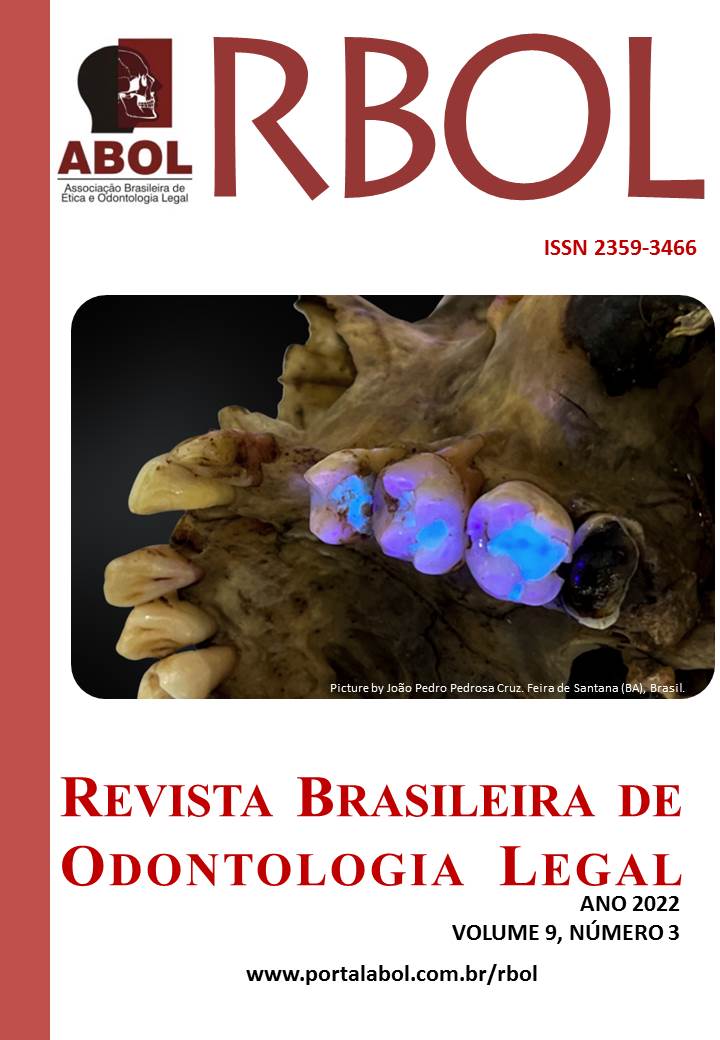Analysis of human identification methods among monozygotic twins: a review of literature
DOI:
https://doi.org/10.21117/rbol-v9n32022-446Keywords:
Twins; Twins, Monozygotic; Forensic Anthropology; Forensic Dentistry; Human Identification., Twins, Twins Monozygotic, Forensic Anthropology, Forensic Dentistry, Human IdentificationAbstract
A number of limitations can be found in the methods in identifying monozygotic twins (MT) due to genetic influences and facial and environmental similarities, the search for reliable methods for genetically identical individuals becomes of great importance for Forensic Science. The objective of this work was to carry out a literature review in search of methods that offer security for identification among MT. For this purpose, search strategies were set up in Lilacs, Medline via Pubmed, Scielo, Scopus and Web of Science databases. We found 3, 27, 2, 388 and 17 articles for each, respectively, totaling 437 studies. Observational studies and case reports were included, with abstract available, and studies that were not fully available for reading, those that did not specify the type of twin, and those that did not present results of the effectiveness of the method for groups of monozygotic twins were excluded. After applying the inclusion and exclusion criteria, 20 studies remained for analysis. It was found that the analysis of individual characteristic points in the fingerprint, tooth development, bite marks, lip print, palatal rugoscopy, anthropometric facial measurements, ocular and vocal impression biometrics, foot prints, crest patterns of nails and veins are effective methods for identifying MT. Given the variety of available methods and the individuality of each case, it is important that the Forensic Dentistry professional knows the methodologies available in the literature. Identification methods capable of differentiating MT from each other have relevant value in aiding justice in terms of human individuality.
Downloads
Published
Issue
Section
License
Os autores deverão encaminhar por email, devidamente assinada pelos autores ou pelo autor responsável pelo trabalho, a declaração de responsabilidade e transferência de direitos autorais para a RBOL, conforme modelo abaixo.
DECLARAÇÃO DE RESPONSABILIDADE E TRANSFERÊNCIA DE DIREITOS AUTORAIS
Eu (Nós), listar os nomes completos dos autores, transfiro(rimos) todos os direitos autorais do artigo intitulado: colocar o título à Revista Brasileira de Odontologia Legal - RBOL.
Declaro(amos) que o trabalho mencionado é original, não é resultante de plágio, que não foi publicado e não está sendo considerado para publicação em outra revista, quer seja no formato impresso ou no eletrônico.
Declaro(amos) que o presente trabalho não apresenta conflitos de interesse pessoais, empresariais ou governamentais que poderiam comprometer a obtenção e divulgação dos resultados bem como a discussão e conclusão do estudo.
Declaro(amos) que o presente trabalho foi totalmente custeado por seus autores. Em caso de financiamento, identificar qual a empresa, governo ou agência financiadora.
Local, data, mês e ano.
Nome e assinatura do autor responsável (ou de todos os autores).

